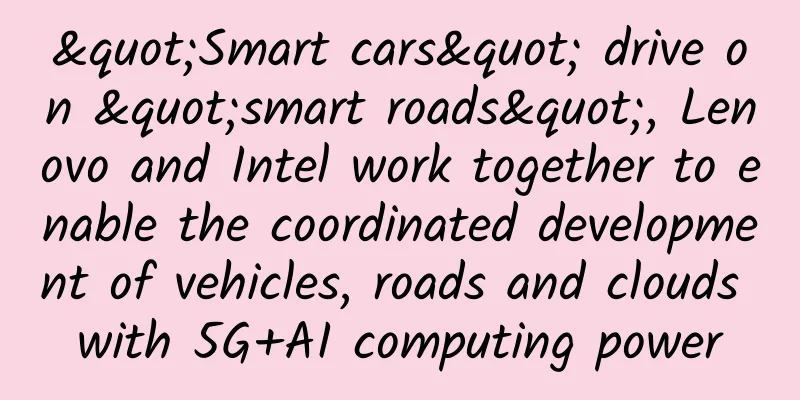"Smart cars" drive on "smart roads", Lenovo and Intel work together to enable the coordinated development of vehicles, roads and clouds with 5G+AI computing power

|
On May 18, Lenovo and Intel jointly demonstrated two star Internet of Vehicles projects in Chongqing for the first time: the first commercial L4+I4 vehicle-road cooperative autonomous driving intelligent logistics distribution system in China - Chongqing Lianglu Cuntan Bonded Port Area; and the first mountainous city Internet of Vehicles demonstration project in western China - Liangjiang Collaborative Innovation Zone . In the afternoon of the same day, a themed forum on "5G + AI computing power empowering smart transportation" was held. Wu Xiangdong, deputy general manager of Tianyi Transportation Technology Co., Ltd. , Cen Ming, professor and director of the Department of Automation and Robotics Engineering of Chongqing University of Posts and Telecommunications, Li, director of Lenovo Cloud Network Integration Business Unit, and Lei Ming , senior platform architect and V2X expert of Intel Corporation, attended the forum and made keynote speeches. Representatives from industry, academia and research gathered together to discuss the development of the Internet of Vehicles in the AI era . The development of smart transportation requires smarter infrastructure. Wu Xiangdong, deputy general manager of Tianyi Transportation Technology Co., Ltd., said: "The prospects for the Internet of Vehicles are bright. With the close cooperation of ecological partners such as communications, software, chips, and hosts, there will be huge room for development. China Telecom will continue to promote the maturity of the industrial chain and application promotion of the Internet of Vehicles, and is committed to becoming a national-level intelligent transportation operator. We will continue to promote the digitalization of transportation with data-driven as the core, and work with partners to build a vehicle-road-cloud-network-map infrastructure, and strive to create a better smart transportation cloud control platform to empower autonomous driving." The technological innovation and application of the Internet of Vehicles requires research and exploration by higher education institutions . Professor Cen Ming of Chongqing University of Posts and Telecommunications said: "Vehicle-road collaboration expands the vision of single-vehicle intelligence and provides strong support for single-vehicle safety. Chongqing University of Posts and Telecommunications has conducted in-depth research on technical solutions such as target detection and tracking by roadside sensors and multi-target tracking in collaboration with R SUs , and is committed to maximizing the effects of intelligent networking efficiently and fully from a technical perspective, making vehicles smarter and traffic smarter." The integrated development of 5G and intelligent computing power promotes the continuous innovation and upgrading of smart transportation . Li, director of Lenovo's Cloud Network Integration Division, said: "The Internet of Vehicles is a very large ecosystem that requires cooperation among industry, academia, research and application to promote industrial development. Lenovo has created a universal, open and intelligent Internet of Vehicles solution based on the core capabilities of 5G, AI and edge computing, combined with leading technologies such as cross-camera vehicle tracking and pure vision-based fusion perception, to continuously promote the coordinated development of "double intelligence". In the AI era, intelligent computing power has become a new engine for the development of the Internet of Vehicles . Lei Ming, senior platform architect and V2X expert at Intel, said: "V2X vehicle -road collaboration will promote the rapid development of technologies such as artificial intelligence, perception fusion, and next-generation communications and networks. Intel's industry-leading high-performance chip products, software for AI and computer vision, and product reference designs will lay a solid foundation for partners to quickly bring products to market, and work with industry partners to fully enable the intelligent upgrade of transportation systems." The joint efforts of industry, academia, research and application continue to promote the rapid development of intelligent networking. As a leading technology company, Lenovo has fully demonstrated through these two star projects the excellent 5G communication products, edge computing platforms and advanced AI algorithms developed based on the end- edge-cloud - network - intelligence IT technology architecture , further highlighting the long-term development of Lenovo's solution service capabilities. Deep integration of 5G and AI computing power: realizing flexible and efficient use of computing network resources Based on the combination of 5G and AI , Lenovo can achieve efficient configuration of network and computing resources, and respond to customer needs in different scenarios with more flexible networks, efficient use of computing power and more precise algorithms, thereby reducing costs and increasing efficiency for customers. In terms of 5G network resource configuration, Lenovo has implemented flexible scheduling and automated management functions for 5G cloud base station resource pools based on containerization technology, supported the evolution of intelligent open architecture, and realized flexible and dynamic adjustment of 5G network resources on demand; in terms of edge computing power , Lenovo can provide advanced resource scheduling solutions that can schedule computing resources at different intersections and in different computer rooms, so that computing resources can be fully utilized and the cost of building the Internet of Vehicles can be reduced; in terms of AI algorithms, Lenovo has deeply optimized AI and data fusion algorithms based on the rich vector instruction set of Intel architecture, greatly reducing edge computing processing latency; diversified edge computing services are deployed using containerization, which can not only achieve resource isolation and reduce the performance loss of the virtual layer, but also improve deployment efficiency and further reduce costs for customers . In 5G+ intelligent computing applications, a series of advanced Intel software and hardware products and technologies provide Lenovo with all-round acceleration from computing power, AI to platform performance : First, a variety of high-performance Intel® architecture processors provide excellent performance output for workloads from edge cloud and central cloud, enabling Lenovo to help customers easily cope with intensive computing needs in intelligent traffic analysis ; second , Intel's OpenVINO™ toolkit enables high-performance reasoning of AI models on heterogeneous computing platforms ; third, Intel® Deep Learning Acceleration Technology can quantify the optimized AI model, achieve higher reasoning efficiency with little loss of accuracy , and significantly reduce construction costs ; fourth , Intel® Smart Edge PWEK (PWEK) technology, which is more deeply integrated with 5G networks, not only realizes resource isolation and reduces the performance loss of the virtual layer, but also effectively reduces deployment time and accelerates service innovation. The first mountainous city Internet of Vehicles demonstration project in the western region: using 5G +AI computing power to achieve cross-intersection target integration In the Liangjiang Collaborative Innovation Zone of Chongqing, a mountain city, driverless shuttle buses are flexibly traveling on public roads in the intelligent network demonstration zone to transport passengers . Without the driver doing anything, the bus can autonomously select lanes, avoid obstacles and pedestrians, and automatically stop at preset stops. This highly technological future transportation scene is based on the technical support of Lenovo's intelligent network + AI computing power vehicle networking solution . Chongqing is known for its complex road conditions and changeable climate. In recent years, the local government has been actively promoting the construction of a complete Internet of Vehicles system and a smart transportation system. In accordance with the concept of zoning and grading construction, the Chongqing Liangjiang New Area Collaborative Innovation Zone has joined hands with Lenovo, Xidi, China Telecom and other companies to carry out intelligent upgrades on roads with a total mileage of about 55 kilometers, realizing 32 types of Internet of Vehicles scenarios such as active bus priority and cross-collision warning, and operating a total of 12 types of vehicles such as autonomous buses and smart connected micro-circulation minibuses. Lenovo has deployed 7 sets of regional edge computing units in the roadside infrastructure. Based on 5G+ intelligent computing technology, the roadside perception information is transmitted back to the regional edge computing, realizing cross-intersection target fusion and computing power scheduling, and supporting the above-mentioned Internet of Vehicles application scenarios. The country's first commercial L4+I4 smart logistics sharing platform : real-time perception of roadside environment beyond visual range In "smart" Chongqing, not only shuttle buses can drive themselves, but also unmanned logistics vehicles. At Chongqing Free Trade Port, a new energy truck that looks like an ordinary truck stopped steadily at a red traffic light. The difference is that there is no driver in the main driving seat of this truck, only a safety officer. With the support of the 5G + AI computing power vehicle-road collaborative roadside infrastructure jointly built by Lenovo and China Telecom , as the traffic light turns green, the self-driving truck slowly starts and drives smoothly to its destination. The above "futuristic" traffic scene is the daily life in Chongqing Lianglu Cuntan Bonded Port. At present, the logistics park urgently needs to improve the efficiency of logistics transportation and reduce the overall logistics service cost. With the support of Chongqing Lianglu Cuntan Bonded Port, Feilida Co., Ltd. has joined hands with Lenovo, China Telecom, Chongqing University of Posts and Telecommunications, Qingling Motors and other companies to empower autonomous driving logistics transportation through 5G+ intelligent computing technology, realizing the end-to-end "L4+I4" level autonomous driving transportation application scenario of logistics vehicles from warehouses to manufacturing plants, improving the supply chain logistics efficiency by 50%, and reducing the cost of supply chain and manufacturing enterprises by 20%, becoming the first 5G new energy intelligent networked transportation vehicle application scenario in the smart terminal industry in Southwest China. Qingling Motors and Chongqing University of Posts and Telecommunications jointly developed an autonomous driving logistics vehicle; Lenovo and China Telecom jointly built a roadside infrastructure for vehicle-road collaboration based on 5G+ intelligent computing power, realizing the beyond-visual-range perception of autonomous driving vehicles in the park, and through continuous monitoring of the park roads and comprehensive analysis of various environmental conditions on the roadside, effectively improving the scene recognition ability of autonomous driving vehicles, and escorting the safety of autonomous driving in the park. The project has created a new integrated logistics and transportation system for manufacturing enterprises with zero inventory, zero turnover, and automatic distribution and dispatching , which not only reduces labor costs , improves logistics efficiency , and reduces carbon emissions , but also breaks down the barriers of two automated information islands, smart warehousing and smart factories . With excellent technical practice and outstanding implementation results, the project won the honorary title of "2022 ICT Outstanding Case·Digital China Innovation Practice Pioneer" recommended by the News and Publicity Center of the Ministry of Industry and Information Technology (People's Post and Telecommunications Press) . The Internet of Vehicles is a key support for the realization of smart transportation and smart cities, and is also an important direction for new infrastructure. In the future, Lenovo will continue to leverage its new IT full-stack technology advantages and Lenovo solution service capabilities , continuously improve its 5G and AI computing capabilities, and create better Internet of Vehicles solutions and services . At the same time, it will also integrate with high-quality partners such as Intel to jointly create a new ecosystem for the Internet of Vehicles and promote the innovative development of smart transportation. |
<<: 5G technology and its impact on the Internet of Things
>>: Dewu App intercepts WiFi at 10,000 meters
Recommend
In the 5G era, will programmers lose their jobs or continue to be popular?
Recently everyone has been discussing such a thin...
Top 5 Reasons for WiFi Device Setup and Connection Issues
Setup and connection issues are notoriously diffi...
Technology “hidden” by life: WIFI
Nowadays, we use WIFI so many times every day tha...
Miao Wei: 5G and other communication infrastructure construction should be appropriately advanced
Miao Wei, deputy director of the Economic Committ...
Wang Xiaochu: Prepare for 5G and avoid making the same mistakes as in the 4G era
Recently, Wang Xiaochu, Chairman and Chief Execut...
48V AC direct supply technology is the future development direction of data centers
With the large-scale construction of data centers...
GraphQL vs. REST: What have you learned?
Overview When creating a web service application,...
51% of companies said that lack of appropriate technical infrastructure and IT systems is a major challenge to digitalization
According to a survey conducted by the NASDAQ, wi...
Why can't the 5G package be changed back to 4G?
Recently, the "5G-forced" incident has ...
A brief discussion of the TCP protocol, finally understand what it does
[[276056]] 1. What is TCP and what does it do? TC...
Six good habits and 23 lessons that Linux operation and maintenance must know to avoid pitfalls!
I have been engaged in operation and maintenance ...
From 1G to 5G and then to 6G, 30 years of mobile communication technology
Since the 1980s, mobile communications have seen ...
How do modern data centers meet the needs of a hyper-connected global economy?
There is no doubt that the ultra-high-speed Inter...
What is the use of "5G+AI"? This comic tells you the answer...
[[425909]] This article is reprinted from the WeC...









![[11.11] LOCVPS: 30% off on all VPSs/50% off on some VPSs, 50 yuan bonus for 300 yuan top-up, KVM/XEN multiple computer rooms available](/upload/images/67cac23c1c8be.webp)